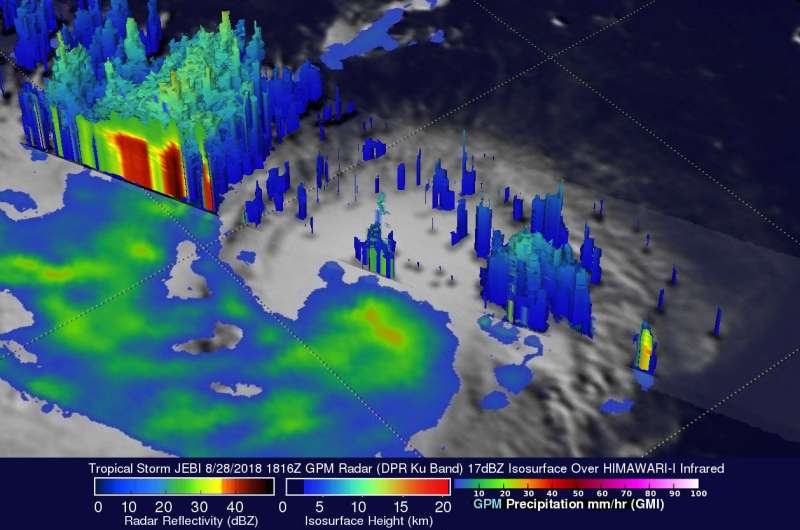GPM Satellite sees Jebi as another tropical threat To Japan

Japan has been afflicted by several tropical cyclones and other extreme weather this summer. GPM analyzed Typhoon Jebi as it was making its way toward Japan.
The Joint Typhoon Warning Center (JTWC) predicts that yet another typhoon called Jebi will be approaching the main islands of Japan early next week. Warm ocean temperatures and low vertical wind shear are providing a favorable environment for Jebi's intensification. The JTWC predicts that the typhoon will have peak sustained winds of 115 knots (132 mph) as it moves over the northern Pacific Ocean toward Japan next week.
The Global Precipitation Measurement mission or GPM core observatory satellite passed above on August 28, 2018 at 2:16 p.m. EDT (1816 UTC) when Jebi was still a tropical storm. The GPM satellite's Microwave Imager (GMI) and Dual-Frequency Precipitation Radar (DPR) instruments collected data in a swath that was centered west of tropical storm Jebi's center of circulation. The most powerful convective storms scanned by the satellite's radar were found in an intense feeder band of thunderstorms south of Jebi's center of circulation. GPM's radar (DPR Ku Band) measured precipitation falling at a rate of over 87 mm (3.4 inches) per hour in that line of storms.
At NASA's Goddard Space Flight Center in Greenbelt, Md. GPM's radar data (DPR Ku Band) was used here to show a simulated 3-D view of tropical storm Jebi's radar reflectivity values. This DPR view, looking toward the southwest, reveals that downpours in the feeder band south of Jebi's center were returning radar reflectivity values of over 52 dBZ to the satellite. A few of these powerful storms were found by the satellite to reach heights above 13.4 km (8.3 miles).
GPM is a joint mission between NASA and the Japan Aerospace Exploration Agency, JAXA.
On Aug. 29 at 11 a.m. EDT (1500 UTC), Jebi's maximum sustained winds were near 80 mph (70 knots/129.6 kph). Jebi was centered near 17.4 degrees north latitude and 150.5 degrees east longitude. Typhoon Jebi was located approximately 330 nautical miles east-northeast of Saipan, and was moving to the west.
Jebi is forecast to move west and stay well north of Guam then curve to the west of Iwo To and head north toward Japan.
Provided by NASA's Goddard Space Flight Center



















